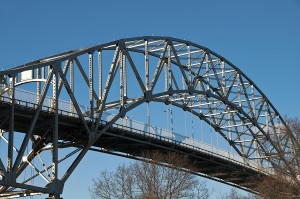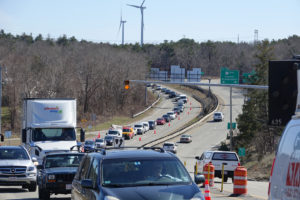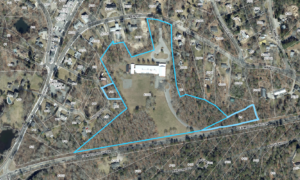 BOURNE – After years of study and review, the federal government will move forward with replacing the aging Sagamore and Bourne Bridges that carry vehicular traffic across the Cape Cod Canal.
BOURNE – After years of study and review, the federal government will move forward with replacing the aging Sagamore and Bourne Bridges that carry vehicular traffic across the Cape Cod Canal.
U.S. Army Corps of Engineers made the formal announcement Thursday night in a media release that said the plan will call for building two new bridges with four travel lanes each and 2 additional auxiliary lanes for acceleration and deceleration.
“Our recommendation, documented in the draft Major Rehab Evaluation Report, is to replace the Bourne and Sagamore highway bridges,” said District Engineer Col. William Conde, commander of the U.S. Army Corps of Engineers, New England District, in a statement.
Both new bridges would also include appropriate bike and pedestrian access.
Meetings to gather public comment on the plan will be held beginning this month on Cape Cod, the South Shore and in Boston.
The Draft Major Rehabilitation Evaluation Report (MRER) and Draft Environmental Assessment are available for review on the website at https://www.CapeCodCanalBridgesStudy.com under the “Documents” tab.
The Corps will accept public comments on the recommendations in the draft bridge study through Nov. 1, 2019.
The existing bridges were constructed 84 years ago and require increasingly more frequent repair and maintenance, which is costly and causes significant impact to traffic crossing the Cape Cod Canal, the Corps said in a statement.
At the end of the public comment period, the Corps will address issues raised by the public and finalize the documents.
The report will also undergo an independent external peer review and be submitted to Corps headquarters in Washington D.C. for decision in February 2020.
“The bridge study will result in a Major Rehabilitation Evaluation Report that will evaluate the risk and reliability of the structures as well as the economic impacts/benefits of a number of alternatives including continuation of routine maintenance, major rehabilitation, and bridge replacement,” said Project Manager Craig Martin, of the Corps’ New England District, Programs and Project Management Division in Concord.
 At the four evening meetings registration will start at 6 p.m. There will be an open house from 6 – 6:30 p.m. with information posters and Corps subject matter experts on hand to answer questions.
At the four evening meetings registration will start at 6 p.m. There will be an open house from 6 – 6:30 p.m. with information posters and Corps subject matter experts on hand to answer questions.
An overview of the study recommendations will begin at 6:30 p.m., followed by a question and answer session.
Public comments can be submitted at the public meetings or online at: www.CapeCodCanalBridgesStudy.com.
Corps public meetings are scheduled for:
– Wednesday, Oct. 16, 2019, Bourne High School auditorium, 75 Waterhouse Road, Bourne, Mass.
– Thursday, Oct. 17, 2019, Plymouth South High School Performing Arts Center, 490 Long Pond Road, Plymouth, Mass.
– Monday, Oct. 21, 2019, Thomas P. O’Neill Jr. Federal Building auditorium, 10 Causeway Street, Boston, Mass. Registration and open house at 1 p.m. Meeting starts at 1:30 p.m.
– Tuesday, Oct. 22, 2019, Nauset Regional High School auditorium, 100 Cable Road, Eastham, Mass.
– Wednesday, Oct. 23, 2019, Barnstable High School Performing Arts Center, 744 West Main Street, Hyannis, Mass.
Read more about the history of the canal bridges
Throughout the process, the Corps and MassDOT have collaborated to ensure Cape Cod residents and visitors have reliable transportation routes to and from Cape Cod.
The MassDOT study examined options at a conceptual level such as modified and improved highway interchanges, and improvements for pedestrian, bicycle and transit access in order to improve multi-modal travel.
The report includes analytical findings, a recommended plan of transportation improvements (short-term, medium-term and long-term), preliminary cost estimates for these improvements, and a comprehensive implementation plan for the recommended improvements.
The bridges, both 396-feet-long and with vertical clearances of 135 feet at mean high water, were constructed as part of the New Deal’s Works Progress Administration under a program entitled the National Industrial Recovery Act of 1933.
They have become structurally obsolete and need significant maintenance work each year, creating major traffic delays over both spans.
The bridges replaced drawbridges that were in place from 1914 to 1935.























